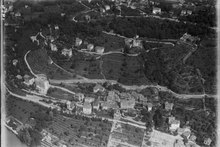Castagnola-Cassarate-Ruvigliana
|
Castagnola-Cassarate-Ruvigliana District of Lugano |
|
|---|---|
| Coordinates | 718.9 thousand / 95832 |
| height | Ø 300 m |
| Residents | 5469 (December 31, 2015) |
| Incorporation | 1972 |
| BFS no. | 519-2004 (Caprino) 519-2005 (Cassarate) 519-2006 (Castagnola) |
| Post Code | 6906 |
Castagnola-Cassarate-Ruvigliana is a district of the city of Lugano in the Lugano East district , in the Lugano district in the Swiss canton of Ticino . It is located at the south-west foot of Monte Brè on Lake Lugano . Until it was incorporated into the city of Lugano in 1972, Castagnola was an independent political municipality .
geography
The village is 329 m above sea level. M. at the south foot of Monte Brè , on the north bank of Lake Lugano and 3 km east of Lugano . Castagnola comprised the fractions Ruvigliana and Suvigliana, the hamlet of Cassarate on the plain and Caprino and Cavallino on the opposite shore of the lake. The district of Cassarate is located at the mouth of the river of the same name in Lake Lugano. The village had 5509 inhabitants in 1991, of which 3453 were in Cassarate.
history
The village was first mentioned as Castigniola in 1335 . Archaeological finds from Roman times indicate an earlier settlement. In the Middle Ages there was a neighborhood ( Vicinia ) encompassing Castagnola, Ruvigliana and Suvigliana around the old church of San Giorgio .
Cassarate, first mentioned in 1335 as Casorago , was founded by the Bishop of Como and did not need to pay taxes (cassina). It was connected to the San Michele Castle . The town of Burgus , which belongs to the castle , fell apart at the end of the Middle Ages. After 1850 Cassarate became part of the infrastructure of Lugano and in 1896 the tram line terminated.
In the 20th century, Castagnola became the largest residential and holiday area in the Lugano area. It was made accessible in 1908 by the Funicolare Monte Brè funicular and in 1955 by a trolleybus line.
population
| Population development | |||||||||
|---|---|---|---|---|---|---|---|---|---|
| year | 1591 | 1801 | 1850 | 1900 | 1950 | 1970 | 1991 | 2015 | 2019 |
| Residents | 157 | 214 | 419 | 1060 | 2926 | 4430 | 5509 | 5469 | 6122 |
Attractions
The village image is classified in the inventory of protected sites in Switzerland (ISOS) as a site of national importance in Switzerland.
- Parish Church of San Giorgio
- Rectory
- Oratory Santi Pietro and Andrea (called San Pietro delle Erbette) from the early 16th century became the private chapel of the Hotel Villa Castagnola, founded in 1885
- Until 1993, Villa Favorita housed the well-known art collection, which is now housed in the Museo Thyssen-Bornemisza in Madrid
- Grand Hotel Villa Castagnola
- The City Archives of Lugano and the Museo Rainis e Aspazija are housed in the Casa Cattaneo .
- Villa Helios, architect: Otto Maraini
- Villa Heleneum (Ethnographic Museum)
- Residence of the poet and writer Francesco Chiesa
- Tettamanti house, architects: Franco Ponti , Milo Navone
- The 18th century prayer chapel of San Michele is located in the San Michele Park
- Studio Foce ex Radio della Svizzera Italiana
- Villa Livadia
event
- Filarmonica di Castagnola
Personalities
literature
- Doriana Comerlati: Thyssen-Bornemisza Foundation, Villa Favorita: museum guide. Thyssen-Bornemisza Foundation, Lugano 1997.
- Virgilio Gilardoni : Il Romanico. Catalogo dei monumenti nella Repubblica e Cantone del Ticino. La Vesconta, Casagrande SA, Bellinzona 1967, pp. 278, 395.
- Antonio Gili: Castagnola. In: Historical Lexicon of Switzerland . September 15, 2003 , accessed December 31, 2019 .
- Guida generale della città di Lugano e dei comuni limitrofi di Paradiso, Castagnola, Viganello, Massagno. Arnold, Massagno 1932.
- Simona Martinoli u. a .: Guida d'arte della Svizzera italiana. Edizioni Casagrande, Bellinzona 2007, pp. 318, 319,320.
- Francesca Pozzoli, Christian Luchessa: Lugano 1939–1945. Guida ai luoghi, ai personaggi e agli avvenimenti della città e dei suoi dintorni in tempo di guerra. La memoria delle Alpi, Fotocomposizione Taiana, Lugano, 2006.
- Rodolfo Rezzonico: Since 70 anni sul palco. In: Rivista di Lugano. Volume 72, number 3, (January 22, 2010).
- Celestino Trezzini : Castagnola. In: Historisch-Biographisches Lexikon der Schweiz , Volume 2, Brusino - Caux , Attinger, Neuchâtel 1924, p. 508 ( digitized version ).
- Various authors: Franco Ponti Architetto 1921–1984. Issue number 2, Fondazione Archivi Architetti Ticinesi, Edizioni Istituto grafico Casagrande SA, Bellinzona 1998.
Web links
- Castagnola: inventory of cultural assets of the Canton of Ticino
- Federal inventory ISOS: Castagnola
- Castagnola-Cassarate quarter on www.lugano.ch
- Castagnola on elexikon.ch
- Cassarate on elexikon.ch
- Castagnola on the Lugano Monte Brè site
Individual evidence
- ↑ Cassarate (river) on portal.dnb.de (accessed on November 22, 2016).
- ^ Antonio Gili: Castagnola. In: Historical Lexicon of Switzerland . February 1, 2005 .
- ^ Funicolare Cassarate-Monte Brè
- ^ Antonio Gili: Castagnola. In: Historical Lexicon of Switzerland . February 1, 2005 .
- ↑ Population of Castsagnola-Cassarate-Ruvigliana at the end of 2019 on statistica.lugano.ch/site/demografia/
- ↑ List of sites of national importance , directory on the website of the Federal Office of Culture (BAK), accessed on January 10, 2018.
- ↑ a b c d e f g h i j k l m Simona Martinoli u. a .: Guida d'arte della Svizzera italiana. Published by the Society for Swiss Art History GSK, Edizioni Casagrande, Bellinzona 2007, ISBN 978-88-7713-482-0 , pp. 318-320.
- ^ Archivio storico Città di Lugano
- ↑ Museo Rainis Aspazija (Italian)
- ^ City archive of Lugano on portal.dnb.de (accessed on November 22, 2016).
- ↑ Filarmonica di Castagnola on portal.dnb.de (accessed on November 22, 2016).








